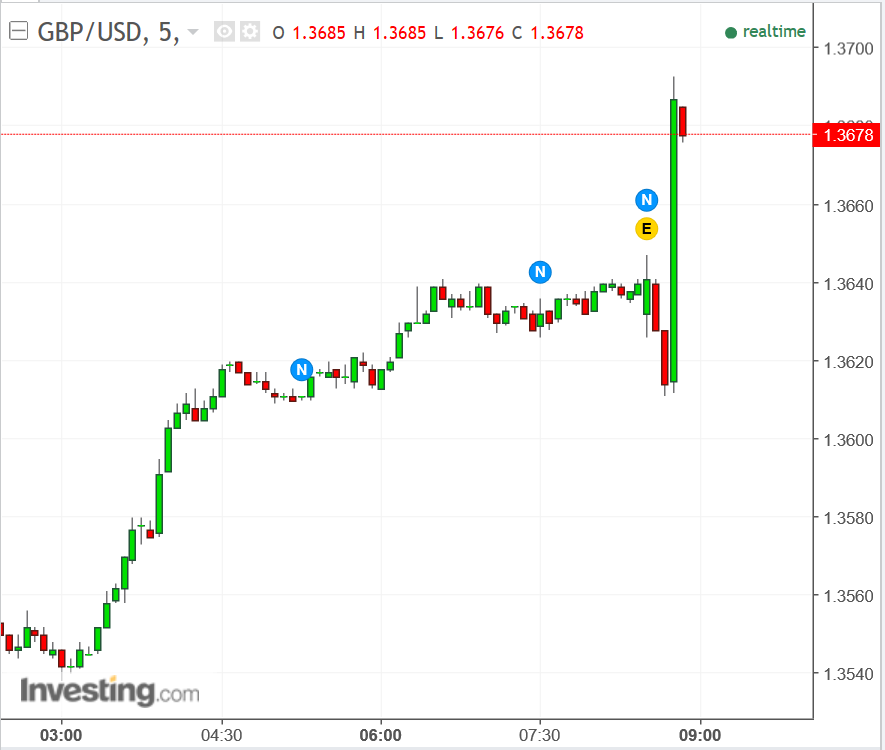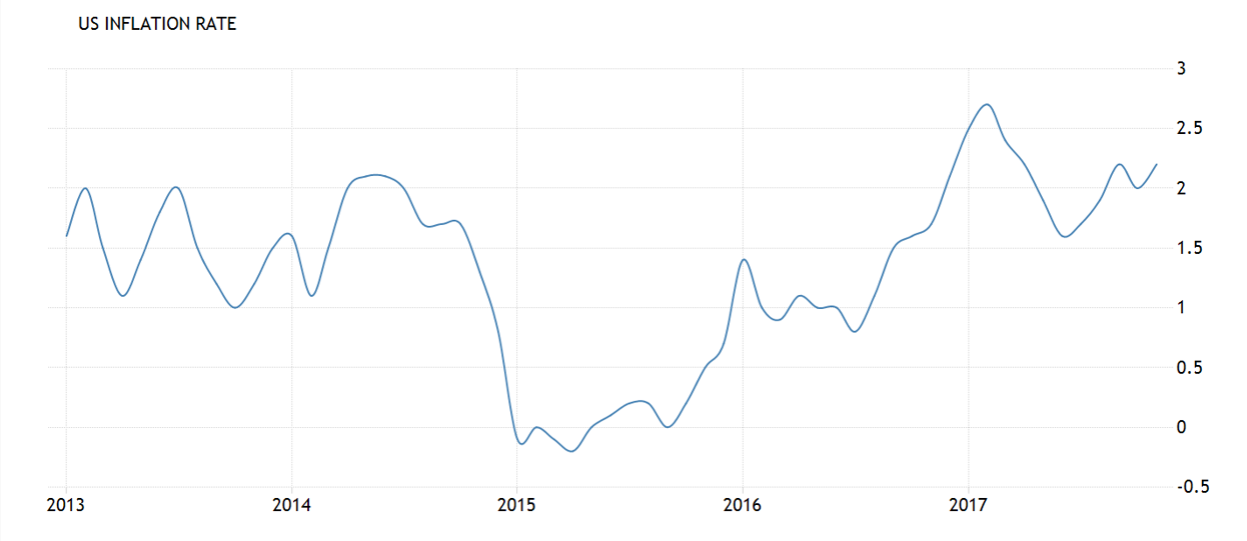US Dollar Fails to Draw a Bid from Mounting Inflation Pressures as Fed Seen Picking Up the Pace

The Dollar is down over half a percent against most pairs after failing to draw a bid from the release of inflation data for December.
Headline inflation slowed in December, rising 2.1% compared to 2016 and as expected, but slightly down from November's 2.2% result, data from the Bureau of Labour Statistics showed on Friday.
On a month on month basis, headline inflation rose only 0.1% on in December, which was down from the previous 0.4% and below the 0.2% expected by economists
Core Inflation rose by 1.8%, beating expectations for a 1.7% rise, but remaining at the same level as it was in November. The Dollar rose and fell in volatile swings after the release.
On a month on month basis, core inflation rose 0.3%, which was up from 0.1% in November and ahead of expectations for a rise of 0.2%.
"Sometimes the story isn't in the headlines, and that's the case for today's US CPI and retail data, where both sets of core data showed heat. For CPI, a 0.1% monthly climb matched expectations, but core prices were up 0.3%, taking the 12-month pace up notch to 1.8%. That's not yet a trend, as the prior month's core was only 0.1%, but it's at least a step up," says Avery Shenfeld, chief economist at CIBC Capital Markets.
EUR/USD was trading at 1.2127 after the release, down about 10 basis points from the 1.2140 pre-release level.
GBP/USD was much higher, however, showing unambiguous Dollar weakness as it traded at 1.3685 following the release from a pre-release level of 1.3640.

Above: Pound-to-Dollar rate shown at 5 minute intervals.
Advertisement:
Get up to 5% more foreign exchange by using a specialist provider to get closer to the real market rate and avoid the gaping spreads charged by your bank when providing currency. Learn more here.
Despite the Dollar's adverse reaction, economists are upbeat about Friday’s inflation numbers, with CIBC's Shenfield saying they should help drive both bond yields and the US Dollar higher.
“The 0.3% m/m gain in core consumer prices in December will reinforce expectations of a Fed rate hike in March and supports our view that the Fed will ultimately increase interest rates by a more aggressive 100bp cumulatively this year,” says Paul Ashworth, chief North American economist at Capital Economics.
In theory, the Dollar should also have benefitted from a rise in retail sales during December, given the implications for economic growth, inflation and interest rates.
Headline sales showed a 5.4% rise compared to last year. This was down from 5.8% - and 0.4% month-on-month, previously but in line with expectations.
The headline retail sales number includes money spent on large ticket items like automobiles - which saw a big rise in the wake of last year’s hurricanes as households replaced damaged vehicles.
“The 0.4% m/m rise in headline retail sales in December was in line with expectations, but the continued strength of underlying sales suggests that real consumption growth accelerated sharply in the fourth quarter of last year,” says Andrew Hunter, another economist at Capital Economics.
Last year’s rise in auto spending meant the headline retail number was always going to fall but, crucially, core retails sales rose faster than was expected in December.
Core retail sales numbers exclude all spending on large ticket items like automobiles because of their distortive effect on trends.
December’s core number shows a stronger than expected trend higher in retail sales, with spending rising by 0.4%, which is above the 0.3% that was forecast by economist.
Inflation Implications
The inflation data's significance lies in the fact that it influences the level at which the Federal Reserve sets interest rates, which in turn has a major impact on the US Dollar.
Currencies and interest rates generally move in tandem - higher interest rates equal a stronger currency because the promise of higher returns stimulates higher inflows of foreign capital.
Whilst US growth as been reasonably robust of late, doubts have lingered about inflation. Those doubts centre on whether low inflation is here to stay or is a short-term phenomenon.
If it's here to stay then the Fed will not raise interest rates too high and may stop raising them altogether quite soon; if not it will probably continue raising them for quite some time, and raise them to a higher endpoint level - or terminal rate as it's called.
This was the reason behind the Dollar's fall after the last Fed rate meeting despite the rate hike - Fed chair Yellen began to doubt whether the current bout of low-inflation was temporary and began to question whether it as potentially longer-term.
Whilst more recent comments from New York Fed President Dudley have been hawkish, after he said, "The Fed may have to press harder on the brakes over the next two years," the Dollar has continued falling as actual data in the form of Producer Prices, otherwise known as PPIs or 'factory gate' prices out yesterday, fell below estimates in December.
Factory gate prices are seen as a leading indicator of what main inflation will be like in the future - not surprisingly, as they monitor levels of inflation for where goods are manufactured before they hit the high-streets and shopping malls.

(Image courtesy of tradingeconomics.com)
Debates about whether the headline or Core CPI is more significant for the Dollar are a moot point, according to ACLS Global chief analyst and head of education Marshall Gittler, who says that headline CPI is as good an indicator as any in terms of market reaction, despite it being widely known that the Fed take their cue from an inflation metric proxy called the Personal Consumption Expenditure deflator (PCE).
"Although the US CPI isn’t the inflation measure that the Fed targets, the market arguably pays more attention to the CPI than to the Fed’s preferred gauge, the personal consumption expenditure (PCE) deflator. Moreover, although the Fed targets the core PCE deflator, the FX market reacts more to the headline CPI than to the core CPI. Who said markets are rational?" says Gittler.
Advertisement:
Get up to 5% more foreign exchange by using a specialist provider to get closer to the real market rate and avoid the gaping spreads charged by your bank when providing currency. Learn more here.




